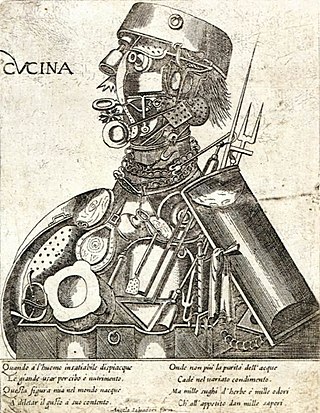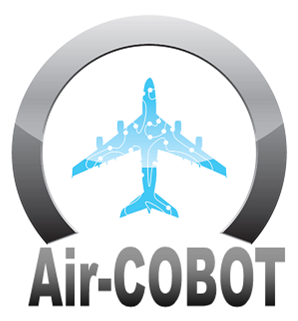Related Research Articles
Computer vision tasks include methods for acquiring, processing, analyzing and understanding digital images, and extraction of high-dimensional data from the real world in order to produce numerical or symbolic information, e.g. in the forms of decisions. Understanding in this context means the transformation of visual images into descriptions of the world that make sense to thought processes and can elicit appropriate action. This image understanding can be seen as the disentangling of symbolic information from image data using models constructed with the aid of geometry, physics, statistics, and learning theory.
Subsumption architecture is a reactive robotic architecture heavily associated with behavior-based robotics which was very popular in the 1980s and 90s. The term was introduced by Rodney Brooks and colleagues in 1986. Subsumption has been widely influential in autonomous robotics and elsewhere in real-time AI.
Robotic control is the system that contributes to the movement of robots. This involves the mechanical aspects and programmable systems that makes it possible to control robots. Robotics can be controlled by various means including manual, wireless, semi-autonomous, and fully autonomous.

Swarm behaviour, or swarming, is a collective behaviour exhibited by entities, particularly animals, of similar size which aggregate together, perhaps milling about the same spot or perhaps moving en masse or migrating in some direction. It is a highly interdisciplinary topic.
Bio-inspired computing, short for biologically inspired computing, is a field of study which seeks to solve computer science problems using models of biology. It relates to connectionism, social behavior, and emergence. Within computer science, bio-inspired computing relates to artificial intelligence and machine learning. Bio-inspired computing is a major subset of natural computation.
Behavior-based robotics (BBR) or behavioral robotics is an approach in robotics that focuses on robots that are able to exhibit complex-appearing behaviors despite little internal variable state to model its immediate environment, mostly gradually correcting its actions via sensory-motor links.

Francesco Mondada is a Swiss professor in artificial intelligence and robotics. He got a Master's degree in Microengineering at the EPFL in 1991 and a PhD degree in 1997. He is one of the creators of the Khepera and directed the design of the S-bot, the e-puck, the marXbot and the Thymio mobile robots. Together, these robots are mentioned in more than 9000 research articles. In particular the Khepera robot is a milestone in the field of bio-inspired and evolutionary robotics.

The s-bot is a small (15 cm) differential wheeled mobile robot developed at the LIS at the EPFL in Lausanne, Switzerland between 2001 and 2004. Targeted to swarm robotics, a field of artificial intelligence, it was developed within the Swarm-bots project, a Future and Emerging Technologies project coordinated by Prof. Marco Dorigo. Built by a small team of engineers of the group of Prof. Dario Floreano and with the help of student projects, it is considered at the time of completion as one of the most complex and featured robots ever for its size. The s-bot was ranked on position 39 in the list of “The 50 Best Robots Ever” by the Wired magazine in 2006.

The Alice is a very small "sugarcube" mobile robot (2x2x2cm) developed at the Autonomous Systems Lab (ASL) at the École Polytechnique Fédérale de Lausanne in Lausanne, Switzerland between 1998 and 2004. It has been part of the Institute of Robotics and Intelligent Systems (IRIS) at Swiss Federal Institute of Technology in Zürich since 2006.

Cockroaches are insects belonging to the order Blattaria. About 30 cockroach species out of 4,600 are associated with human habitats. Some species are well-known as pests.

Remote control animals are animals that are controlled remotely by humans. Some applications require electrodes to be implanted in the animal's nervous system connected to a receiver which is usually carried on the animal's back. The animals are controlled by the use of radio signals. The electrodes do not move the animal directly, as if controlling a robot; rather, they signal a direction or action desired by the human operator and then stimulate the animal's reward centres if the animal complies. These are sometimes called bio-robots or robo-animals. They can be considered to be cyborgs as they combine electronic devices with an organic life form and hence are sometimes also called cyborg-animals or cyborg-insects.
Nouvelle artificial intelligence (AI) is an approach to artificial intelligence pioneered in the 1980s by Rodney Brooks, who was then part of MIT artificial intelligence laboratory. Nouvelle AI differs from classical AI by aiming to produce robots with intelligence levels similar to insects. Researchers believe that intelligence can emerge organically from simple behaviors as these intelligences interacted with the "real world," instead of using the constructed worlds which symbolic AIs typically needed to have programmed into them.

Webots is a free and open-source 3D robot simulator used in industry, education and research.
A hierarchical control system (HCS) is a form of control system in which a set of devices and governing software is arranged in a hierarchical tree. When the links in the tree are implemented by a computer network, then that hierarchical control system is also a form of networked control system.

A cyborg —a portmanteau of cybernetic and organism—is a being with both organic and biomechatronic body parts. The term was coined in 1960 by Manfred Clynes and Nathan S. Kline.

A robotic vacuum cleaner, sometimes called a robovac or a roomba as a generic trademark, is an autonomous robotic vacuum cleaner which has a limited vacuum floor cleaning system combined with sensors and robotic drives with programmable controllers and cleaning routines. Early designs included manual operation via remote control and a "self-drive" mode which allowed the machine to clean autonomously.

LAURON is a six-legged walking robot, which is being developed at the FZI Forschungszentrum Informatik in Germany. The mechanics and the movements of the robot are biologically-inspired, mimicking the stick insect Carausius Morosus. The development of the LAURON walking robot started with basic research in field of six-legged locomotion in the early 1990s and led to the first robot, called LAURON. In the year 1994, this robot was presented to public at the CeBIT in Hanover. This first LAURON generation was, in contrast to the current generation, controlled by an artificial neural network, hence the robot's German name: LAUfROboter Neuronal gesteuert. The current generation LARUON V was finished in 2013.

Air-Cobot (Aircraft Inspection enhanced by smaRt & Collaborative rOBOT) is a French research and development project of a wheeled collaborative mobile robot able to inspect aircraft during maintenance operations. This multi-partner project involves research laboratories and industry. Research around this prototype was developed in three domains: autonomous navigation, human-robot collaboration and nondestructive testing.

Silvia Ferrari is an American aerospace engineer. She is John Brancaccio Professor at the Sibley School of Mechanical and Aerospace Engineering at Cornell University and also the director of the Laboratory for Intelligent Systems and Control (LISC) at the same university.
References
- 1 2 3 Colot, Alexandre; Caprari, Gilles; Siegwart, Roland (2004). "InsBot: Design of an autonomous mini mobile robot able to interact with cockroaches". IEEE International Conference on Robotics and Automation, 2004. Proceedings. ICRA '04. 2004. pp. 2418–2423 Vol.3. doi:10.1109/ROBOT.2004.1307423. hdl:20.500.11850/82534. ISBN 978-0-7803-8232-9. S2CID 12776519.
- 1 2 3 4 5 Hearn, Louisa (2006-05-12). "Robo-roach on the warpath". theage.com.au.
- 1 2 3 4 Caprari, Gilles; Colot, Alexandre; Siegwart, Roland; Halloy, Jose; Deneubourg, Jean-Louis (June 2005). "Animal and Robot Mixed Societies". IEEE Robotics & Automation Magazine. 12 (2): 58–65. doi:10.1109/MRA.2005.1458325. S2CID 13593913.
- ↑ Sempo, Gregory; Depickere, Stephanie; Ame, Jean-Marc; Detrain, Claire; Halloy, Jose; Deneubourg, Jean-Louis (2006). "Integration of an Autonomous Artificial Agent in an Insect Society: Experimental Validation". From Animals to Animats 9. Lecture Notes in Computer Science. Vol. 4095. pp. 703–712. doi:10.1007/11840541_58. ISBN 978-3-540-38608-7.